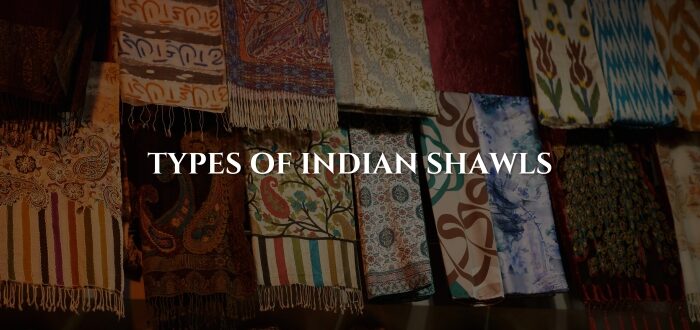Top 10 Types of Indian Shawls
India is a land of immense cultural diversity, and shawls have long held a special place in its heritage. The roots of Indian shawls can be traced back to the 14th century in Kashmir, where they initially served as winter essentials and later evolved into symbols of elegance. While originally worn for warmth during winter, these Kashmir shawls quickly became a fashion statement. From stoles and scarves worn during summer to traditional bridal shawls and ornate wraps that have been passed on down as heirloom pieces, shawls have become the embodiment of elegance, luxury and tradition.

These textiles have become more than clothing—they’re carriers of identity and legacy.
From the snow-covered valleys of Kashmir to the tribal heartlands of Odisha, each shawl tells a story of its region, its people, and its craftsmanship.
In this blog, we’ll take a journey through the different types of shawls, their cultural roots, and what makes each one unique. So, the next time you find yourself eyeing a vintage shawl on an online auction site like Giftex, you’ll know exactly what you’re looking at—and why it matters.
Cultural Significance of Indian Shawls
Indian shawls are not just garments—they are symbols of identity, heritage, and deep-rooted tradition. Traced back to the 14th century, shawls have been woven into the cultural fabric of the country for generations. They carry cultural meanings that go far beyond warmth or fashion.
Over the centuries, shawls have evolved into cultural emblems that represent regions, communities, and even social status. Each shawl—whether a Pashmina from Kashmir, or a traditional Naga tribal shawl, tells a story about the people who made it, the place it came from, and the customs it preserves.
Also Read: The Cultural Significance of Shawls in India
Here are the top 10 types of Indian shawls

-
Pashmina Shawls
Origin: Kashmir
Fabric: Fine Pashmina wool from Changthangi goats
Features: Soft, warm, lightweight, and luxurious
Design: Solid shades, intricate Sozni embroidery, paisley or floral patterns
Significance: Symbol of royal elegance, a heritage gifting item, and a fashion investment. Crafted from the fine fleece of the Changthangi goat, each Pashmina shawl is a masterpiece of comfort and craftsmanship, often passed down as heirlooms.
-
Kani Shawls
Origin: Kanihama, Kashmir
Fabric: Pashmina wool
Features: Dense, richly woven, luxurious feel
Design: Woven motifs of florals and paisleys using wooden spools (kanis)
Significance: One of the most complex and labour-intensive shawls in the world. Kani shawls are prized collector items and cultural treasures recognized for their intricate loom weaving technique.
Also Read: Elegance of Kani Shawls
-
Kullu Shawls
Origin: Himachal Pradesh
Fabric: Wool or Angora blend
Features: Warm, thick, durable for high-altitude climates
Design: Bold geometric patterns, colourful borders, handloom woven
Significance: Represents the identity and culture of the Himachali people. Kullu shawls are frequently worn by locals and are gaining popularity for their rustic charm and comfort.
- Phulkari Shawls
Origin: Punjab
Fabric: Hand-spun cotton or silk base
Features: Heavily embroidered, vibrant, and festive
Design: Dense floral embroidery using silk thread, usually stitched from the reverse side
Significance: Traditionally made for weddings and dowries. Phulkari shawls are a symbol of joy, femininity, and Punjabi heritage, often passed down as family heirlooms.

-
Naga Shawls
Origin: Nagaland
Fabric: Wool or cotton blends
Features: Thick, sturdy, tribal character
Design: Geometric stripes, warrior symbols, animal motifs in black, red, and white
Significance: Each design signifies the tribe, status, and achievements of the wearer. Naga shawls are cultural identifiers and ceremonial garments, especially for dances and festivals.
-
Abari Shawls
Origin: Kutch, Gujarat
Fabric: Cotton or wool blend
Features: Folk-inspired, colourful, textured
Design: Intricate embroidery with mirror work, tribal patterns, and geometric shapes
Significance: Worn during festivals and celebrations in Gujarat. Abari shawls reflect the artistic expression and daily life of the Rabari and nomadic tribes of the region.
-
Jamawar Shawls
Origin: Kashmir
Fabric: Silk, wool, or blended fabrics
Features: Ornate, rich texture, heavier fabric
Design: All-over brocade-style weaving or embroidery, usually with paisleys and Mughal motifs
Significance: Once worn exclusively by royalty. Jamawar shawls are considered regal attire and are popular as wedding gifts or heritage pieces.
https://www.youtube.com/watch?v=8JcctiOtBQQ
-
Embroidered Shawls
Origin: Multiple regions – Kashmir, Rajasthan, Uttar Pradesh
Fabric: Wool, silk, cotton blends
Features: Artistic, embellished, often custom-made
Design: Varies by style – Sozni (fine), Aari (chain stitch), Zardozi (metallic), Crewel (thick wool)
Significance: These shawls are wearable art forms, showcasing India’s embroidery legacy. They are worn for ceremonies, festivals, and formal occasions.
-
Do-Shalla Shawls
Origin: Kashmir (Mughal tradition)
Fabric: Pashmina or fine wool
Features: Twin shawls or mirrored designs, luxurious and grand
Design: Two identical shawls or a single reversible shawl with mirrored embroidery
Significance: Historically worn by Mughal emperors and noblemen. Today, Do-Shalla shawls are prized for their symmetry and historical association with prestige and power.
-
Pattu Shawls
Origin: Rajasthan and Himachal Pradesh
Fabric: Wool
Features: Warm, earthy, practical
Design: Stripes or checks in natural and dyed shades, often handwoven
Significance: Popular in rural communities for everyday wear and protection from the cold. Pattu shawls are simple yet stylish, reflecting India’s grassroots textile traditions.
Choosing the Right Shawl
Choosing the perfect shawl isn’t just about picking something pretty—it’s about finding the right blend of purpose, personality, and practicality.
-
Consider the Occasion
Are you buying a shawl for a winter wedding, daily wear, or as a gift?
Formal events or weddings: Opt for intricate shawls like Jamawar, Kani, or embroidered Pashmina.
Everyday wear: Choose lighter and versatile options like Kullu, Pattu, or Phulkari.
-
Match Your Style
Shawls can reflect who you are—traditional, minimalistic, boho, or bold.
Prefer elegance? Go for Sozni-embroidered Pashmina or Do-Shalla.
Love colour and drama? Choose a Phulkari, Abari, or Naga shawl.
-
Know the Climate
Your choice should also suit the weather:
Winter Wear: Look for wool-based shawls, such as Pattu, Kullu, or Kani.
Mild Weather: Lightweight options, such as cotton-based Phulkari or silk blends, work well.
-
Factor in Budget
Be clear about your purpose and how often you’ll use the shawl.
If you’re seeking something timeless and heirloom-worthy, consider high-quality options like Pashmina or heavily embroidered shawls. Their craftsmanship, durability, and artistic value make them worthy long-term investments.
-
Check Authenticity and Craftsmanship
Look for:
- GI tags or certification (especially for Pashmina)
- Handwoven vs. machine-made details
- Fine embroidery, symmetry, and finishing
Indian Shawls with Heritage and Style
In recent years, Indian shawls have gained global recognition—not just as winter accessories, but as high-fashion, cultural symbols. Luxury brands and designers are increasingly incorporating traditional Indian shawl patterns into their collections, celebrating the artistry and heritage behind them. This rising global interest has made shawls not only a style choice but also a thoughtful investment.
As the allure of these handcrafted textiles continues to grow, understanding the different types of shawls becomes more important than ever. Whether you’re drawn to the elegance of a Kashmiri Pashmina or the bold heritage of a tribal Naga shawl, knowing the origin, craftsmanship, and cultural significance behind each piece adds meaning and value to your choice.
A shawl is more than fabric—it’s a legacy you wear. The more you understand its story, the more powerful your style becomes.






